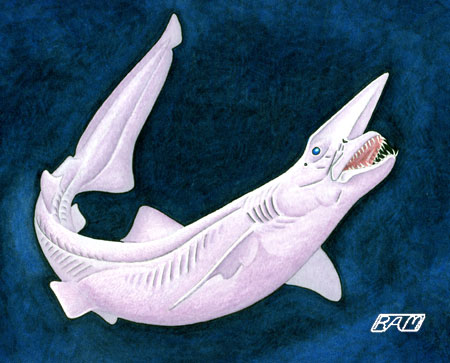Deep Sea: the Twilight Zone and Beyond
Goblin Shark
Named for its peculiar, blade-like snout and toothy, forceps-like jaws, the Goblin Shark (Mitsukurina owstoni) is arguably the weirdest of sharks. It grows to a length of at least 12.5 feet (3.8 metres), has a flabby body and soft skin that, in life, is colored pinkish grey. Based on its skeleton and other features, it is believed to be the most ‘primitive’ of the lamnoid sharks, a group which includes more familiar sharks such as the Sandtiger (Carcharias taurus), Common Thresher (Alopias vulpinus), Shortfin Mako (Isurus oxyrinchus), and White Shark (Carcharodon carcharias). Apparently, early in its evolutionary history, the Goblin Shark became specialized for a deep-sea existence.
Just the Facts:
Size:
Reproduction:
Diet:
Habitat: Rocky Reefs, Deep Sea Depth: 130-4,265 ft (40-1,300 m), typically between 200-920 ft (60-280 m) off southern Honshu, Japan Distribution: Tropical Eastern Pacific, Caribbean, Eastern North Atlantic/Mediterranean, Southern African, Southeast Australian/New Zealand, Japanese |
Discovered in 1898 off Yokohama, Japan, the Goblin Shark is known from fewer than 50 specimens. About half of these are from Sagami and Saruga Bays, Japan, with most of the remainder from Kaikoura, New Zealand, and southern Africa. In September 1998, the first Goblin Shark specimen from U.S. waters was captured by a drift gillnetter off southern California. From bycatches on deep-sea longlines set for Black Scabbardfish (Aphanopus carbo), there also appears to be a substantial population of Goblin Sharks off Madeira, Portugal. The tooth of a Goblin Shark was found embedded in an undersea cable set on the bottom of the Indian Ocean at a depth of 750 fathoms (1,370 metres). The foregoing suggests that the Goblin Shark is widely but patchily distributed and probably quite common. Yet captures are rarely reported and the basic life history of this species is thus very poorly known.
Almost everything about the Goblin Shark’s body reflects the harshness of its deep-sea habitat. Its muscle blocks are soft and mushy, suggesting that the Goblin Shark is not a strong swimmer and conserves its energy by leading a life of lethargy. Its skin lacks the collagenous toughness typical of shark skin and its cartilaginous skeleton is simple and poorly calcified, probably reflecting the Goblin’s nutrient-poor habitat. Yet it is also quite large, suggesting that the Goblin Shark is somehow able to obtain sufficient food to sustain its considerable mass.
Little is known about the Goblin Shark’s diet. Identifiable stomach contents have been reported for only seven specimens from four countries. Stomachs of Japanese individuals contained mostly half-digested teleost fish parts (fin rays, muscle blocks, and vertebrae). But one large individual also contained crab remains, confirming suspicions that the Goblin Shark feeds at or near the bottom. A large specimen from southeastern Australia contained an elongate silvery structure with a central lumen — probably a teleost swim bladder. A small specimen from off South Africa contained pelagic octopus, crabs, and a deep-water rockfish known as a Jacopever (Helicolenus dactylopterus). A small specimen from New Zealand contained a single, unidentified eye lens. From such meager data, few meaningful conclusions about the feeding habits of Goblin Sharks can be drawn.
In April 1998, a 50-inch (128-centimetre) immature female Goblin Shark was captured off Kaikoura, New Zealand, in a bottom gillnet set at a depth of 1,050 to 1,445 feet (320 to 440 metres). Evidence contained in the gut of that one specimen challenged everything we thought we knew about Goblin Shark dining habits. The little Goblin’s stomach was mostly empty, but — among other remains — included the beak from an immature squid of a species called Teuthowenia pellucida, a small number of fish scales similar to those of myctophid lanternfishes, and four, pea-sized ostracod crustaceans of a species known as Macrocypridina castanea rotunda. All of these prey items are bioluminescent vertical migrators of the mesopelagic zone. These stomach contents attest that at least some Goblin Sharks feed far off the bottom, as part of the midwater community and suggest that vision may play a role in prey detection.

The Goblin Shark is richly endowed with sensors to help it detect prey in the blackness of the deep-sea. Unlike most deep-sea sharks, the Goblin has smallish eyes with fully functional irises that contract and dilate. This suggests that, at least occasionally, the Goblin Shark encounters downwelling sunlight and that it may be able to detect the bioluminescence of midwater prey. Alternatively, the Goblin Shark’s elongate, flattened snout is peppered with ampullae of Lorenzini. These electroreceptors are extensions of the lateral line system and are based on relatively minor modifications of the same functional units, known as “hair cells”. Certain halfbeaks (family Hemiramphidae) detect prey at night using vibration-sensitive hair cells in lateral line organs that extend along their elongate lower jaws. By analogy, perhaps the Goblin Shark’s electrosensor-studded, spatulate snout acts as a forward-projecting prey detector. But this is probably not an either/or matter. It seems likely that, in the vastness of the deep-sea, the Goblin Shark takes advantage of as many prey-detecting strategies as it is able.
The front end of the Goblin Shark is impressively adapted to capturing deep-sea prey. Its teeth are slender with smooth-edged blades, making them ideal for grasping slippery-bodied prey that is small enough to swallow whole. The jaws are loosely slung and highly protrusible, greatly increasing the predator’s reach. The Goblin Shark’s basihyal (‘tongue’) is large and highly mobile, while its throat and gill muscles are at least somewhat expandable. By coordinating jaw-protrusion, basihyal elevation, throat and gill muscle expansion, the Goblin Shark can create a sudden pharyngeal vacuum powerful enough to hoover up all but the strongest-swimming of prey. Understood in a functional context, the Goblin Shark’s apparently ‘bizarre’ features seem remarkably efficient and even sensible.

